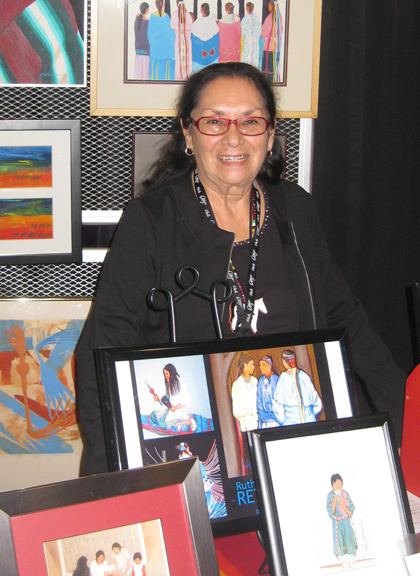 | ||
The Peoria (or Peouaroua) people are a Native American tribe. Today they are enrolled in the federally recognized Peoria Tribe of Indians of Oklahoma. Historically, they were part of the Illinois Confederation.
Contents
Language and name
Traditionally, the Peoria spoke a dialect of the Miami-Illinois language. The name "Peoria" derives from their autonym or name for themselves in the Illinois language, peewaareewa (modern pronunciation peewaalia). Originally it meant, "Comes carrying a pack on his back." No speakers of the Peoria language survive. Along with the language Miami, a smaller number of the Peoria tribe of Oklahoma speaks Cahokia, Moingwea and Tamaroa.
Government
The Peoria Tribe of Oklahoma is headquartered in Miami, Oklahoma, and their tribal jurisdictional area is in Ottawa County. Of the 2,925 enrolled tribal members, only 777 live within the state of Oklahoma. John P. Froman is the tribe's elected Chief, currently serving a four-year term.
Economic development
The Peoria issue their own tribal vehicle tags and operate their own housing authority. The tribe owns one casino and the Peoria Ridge Golf Course. The estimated annual economic impact of the tribe is $60 million. Tribal businesses, the Peoria Gaming Center, Buffalo Run Casino and Hotel, and Joe's Outback are all located in Miami, Oklahoma.
History
The Peoria are Algonquian-speaking people, whose ancestors came from what is now Illinois, Michigan, Missouri, and Ohio. Once thought to be descendants of the Cahokia Mississippian culture of Moundbuilders, they are now believed to be related to Algonquian-speaking peoples of the Great Lakes and East Coast. The Peoria were one of the many Illinois tribes encountered by the explorers, Father Jacques Marquette and Louis Jolliet. French Jesuit missionaries converted tribal members to Roman Catholicism. Father Jacques Gravier, superior of the Illinois mission, compiled the most extensive dictionary of Kaskaskia Illinois-French terms, nearly 600 pages and 20,000 entries.
The Peoria migrated southwest into Missouri Territory after 1763. In 1818, the Treaty of Edwardsville included the cession of Peoria lands in Illinois to the United States. By the 1832 Treaty of Lewisville, they ceded Missouri lands in exchange for land in Kansas, near the Osage River.
Infectious disease, to which they had no natural immunity, and intertribal wars drastically reduced the tribe's numbers. In 1849, members of the Kaskaskia, Peoria, Piankeshaw, and Wea tribes formed a confederacy under the Peoria name. The confederation also included the last members and descendants of the Cahokia, Moingwena, Michigamea and Tamaroa tribes, who had become a part of the Peoria many year before, as well as the Pepikokia, who had joined the Wea and Piankashaw in the later part of the 18th Century. In 1851, an Indian agent reported that the Peoria and the Kaskasia, along with their allies, had intermarried among themselves and among white people to such an extent that they had pctically lost their identities. An 1854 treaty recognized this as a factual union and called these groups the Confederated Peoria. The treaty also provided for opening the Peoria-Kskaskia and the Wea-Piankashaw reserves to settlement by non-Indians.
After the Civil War, most of the confederated tribe signed the 1867 Omnibus Treaty. By this means, the U. S. government purchased land from the Quapaw tribe and relocated the majority of the Peoria tribe to on a 72,000 acres (290 km2) reservation in Indian Territory, part of present-day Ottowa County, Oklahoma. Congress enacted a law to unite the Miami tribe of Kansas with the Confederated Peoria. The Peoria and Miami lands were allotted to the enrolled members in 1893. In 1907, any surplus land was turned over to Ottawa County.
Under the Dawes Act and Curtis Act of 1898, the US government attempted to make individual allotments of land to heads of families, to allow separate ownership and cultivation of land, and break up the common landholdings of the tribes. It was part of an effort to have the tribes assimilate to European-American ways. At the same time, they forced tribal governments to dismantle. In 1939, after passage of the Oklahoma Indian Welfare Act, the tribe reorganized and re-established its traditional form of council government.
During the 1950s, the US government pursued a policy of Indian termination to end its special relationship with tribes. It dissolved the Peoria tribal government, which lost federal recognition in 1959. Tribal members objected and began the process to regain federal recognition, which they achieved in 1978. The Miami tribe never lost its Federal recognition.
The descendants of the Piankeshaw, Kaskaskia, and Wea, all members of the Illinois Confederacy, are also enrolled in the Peoria Tribe of Indians of Oklahoma.
